You aren’t the first person to bring home a brand-new puppy only to go cross-eyed while looking at the myriad of dog food options available.
Lamb, salmon, chicken; dry, wet, semi-moist; hypoallergenic, all-natural, grain-free, grain-inclusive — the choices are endless!
But don’t despair – selecting high-quality puppy food is not as hard as it initially seems. By considering a few simple criteria, you can pick a great dog food for your growing (and adorable) puppy.
Below, we’ll share the best dog food for puppies and ways to pick the right food for your new barkin’ baby.
In a hurry and just want a quick recommendation? Check out our quick picks!
Puppies and Adult Dogs Have Different Nutritional Needs

Many new pet owners wonder if puppies truly require a different type of dog food than adult dog food or if the entire idea is just a marketing ploy.
There are a lot of misleading claims and hype in the dog food world, but this one is actually true: Puppies do require a different type of food than adult dogs do.
In fact, they have specific nutritional needs which differ markedly from those of adults.
Consider, for example, that dogs grow most rapidly while they are young.
In fact, most of a dog’s growth occurs during the first year of life (although many breeds continue to grow until reaching about 3 years of age).
This rapid growth requires a great deal of resources and essential vitamins — more, in fact, than adult dogs need.

Accordingly, to ensure your puppy reaches her full growth potential and develops a strong bone structure, you must offer her a balanced diet specifically formulated for young, growing dogs rather than adult dog food.
Don’t misunderstand: There’s nothing “dangerous” about adult dog food, and feeding your puppy a bowl of adult dog food in a pinch is unlikely to cause any serious health problems.
But it is very important that you do not do so as a matter of practice – the long-term risks are simply too great.
Besides, adult dog food may upset your pup’s tummy and lead to digestive issues, which isn’t good for her, or the human trying to housebreak her.
The 11 Best Dog Foods for Puppies: Different Foods for Different Puppies!

There is no “best” dog food for all puppies — the best food for your puppy will be different than the best food for some other puppy. You just need to consider your pup’s specific needs, factor in your preferences, and talk the issue over with your vet to arrive at the best option.
We’ll try to help below, by sharing some of the best puppy foods for addressing different needs. And to make it easier, we’ve broken the best puppy foods down into fresh, dry, and wet options!
3 Best Fresh Dog Foods for Puppies
If you want one of the very best puppy foods available for your cute-and-cuddly new canine, it’s hard to beat fresh dog food.
Most are made with super-premium ingredients, cooked up in US-based kitchens, and custom-formulated for your specific pet.
Fresh dog foods certainly aren’t cheap, but many owners are glad to cough up a little more cash to reap the rewards they provide by feeding one of these premium dog foods! Check out our picks for the best dog food for puppies served fresh!
1. Nom Nom
About: Nom Nom’s fresh dog food is ideal for owners who don’t mind spending a bit more to give their pooch the very best. Custom-crafted for your pooch’s specific needs and made in the USA with fresh, US-sourced, restaurant-quality ingredients, you will love the way your pooch enjoys chowing down on this super-premium puppy food packed with fresh meat!
Features:
- Custom-crafted dog food designed by a board-certified veterinary nutritionist
- Made from high-quality ingredients to spoil your new puppy rotten
- Available in your choice of four different proteins (real chicken, turkey, pork, or beef)
- Built on a home-delivery, subscription-based model.
- You can order variety packs without enrolling in the subscription service
- Nom Nom will leave out foods your pooch is allergic to
Sample Ingredient List (Turkey Fare Recipe):
Ingredients List
Ground turkey, brown rice, eggs, carrots, spinach...,
dicalcium phosphate, calcium carbonate, salt, potassium chloride, fish oil, natural flavor, vinegar, citric acid, taurine, choline bitartrate, zinc gluconate, ferrous sulfate, vitamin E supplement, copper gluconate, niacin (vitamin B3), manganese gluconate, vitamin A supplement, thiamine mononitrate (vitamin B1), pyridoxine hydrochloride (vitamin B6), selenium yeast, riboflavin (vitamin B2), vitamin B12 supplement, cholecalciferol (source of vitamin D3), potassium iodide.
Pros
- Unmatched taste that most puppies love
- Packed with nutritious ingredients, including premium proteins and whole grains
- Available in grain-free and grain-inclusive varieties
- Super-convenient home delivery
- Pre-portioned packaging makes serving easy
- Some owners have noticed improvements in coat condition, elimination habits, and energy levels after feeding this dog food
Cons
- The only real downside to this dog food is the price
- Primarily designed as a subscription service (but you aren’t required to sign up for a subscription, and you can cancel at any time)
We think Nom Nom is the best fresh food for most puppies, but there are other options available. Check out our complete guide to fresh foods for dogs to see some other manufacturers we like and learn more about fresh foods in general!
2. Ollie
About: Ollie is a custom dog food catered to your puppy’s individual needs and delivered right to your door. Made in the USA with human-grade ingredients and gently cooked to preserve flavor and essential nutrients, this mash of meat and produce factors in your dog’s age, activity levels, and more to fine-tune each meal and promote lifelong health and weight management.
Features:
- Meat (like real chicken) is always the first ingredient
- Each meal is preportioned, making mealtime a breeze
- Grain-free and grain-inclusive recipes are available among the 5 fresh options
- Shipped to you frozen to preserve freshness
- Can be fed on its own or added to your dog’s kibble
- Doesn’t contain any artificial flavors
- All Ollie fresh foods are vet-formulated and meet the AAFCO standard for all life stages
Sample Ingredient List (Chicken):
Ingredients List
Chicken, rice, carrots, chicken livers, peas...,
potatoes, spinach, cranberries, tricalcium phosphate, salmon oil, salt, taurine, zinc gluconate, vitamin E supplement, ferrous sulphate, copper amino acid chelate, manganese amino acid chelate, cholecalciferol (vitamin D3) supplement, riboflavin (vitamin B2), thiamine hydrochloride (vitamin B1), pyridoxine hydrochloride (vitamin B6), potassium iodide
Pros
- Hard to match the quality of human-grade ingredients
- Recipes are rich in produce and bonus ingredients like nutrient-dense organ meat
- Most dogs go gaga for the taste
- Comes with a money-back guarantee
Cons
- Pricing is steep
- Some recipes contain potatoes and peas — problematic ingredients for some pet parents
3. Open Farm
Tasty puppy food that's made with non-GMO produce and Ocean Wise® approved salmon to help your pup and the planet!
About: Want to give your pooch a nutritious food that’s also good for the planet? Open Farm has you covered! Open Farm’s fresh foods are made with a variety of non-GMO produce and ethically sourced and harvested proteins. Additionally, Open Farm provides unparalleled ingredient-sourcing transparency — they show you exactly where each ingredient in their recipes comes from!
Features:
- Meals are all pre-portioned in individual containers
- Open Farm discloses the sourcing information for all of their ingredients
- All livestock used in their recipes are humanely raised
- Sous vide cooking style eliminates bacteria while retaining flavor
- Pouches are easy to prepare — just defrost and serve
- Made with Ocean Wise approved, environmentally friendly salmon
Ingredient List:
Ingredients List
Humanely Raised Chicken, Wild-Caught Salmon, Humanely Raised Pork, Chicken Liver, Carrots...,
Apples, Kale, Butternut Squash, Chicken Bone Broth, Pumpkin, Flaxseed, Tricalcium Phosphate, Coconut Oil, Salt, Sunflower Oil, Vitamin E Supplement, Vitamin A Supplement, Niacin Supplement, Pantothenic Acid, Riboflavin Supplement, Vitamin D3 Supplement, Thiamine Mononitrate, Vitamin B12 Supplement, Pyridoxine Hydrochloride, Folic Acid, Salmon Oil, Chia Seeds, Dried Chicory Root Extract, Choline Chloride, Zinc Proteinate, Iron Proteinate, Copper Proteinate, Manganese Proteinate, Selenium Yeast, Calcium Iodate, Dried Kelp, Turmeric, Cinnamon
Pros
- Most dogs love the taste of these fresh foods.
- Owners love the ability to see the exact source of the ingredients used.
- We love that it includes nutritional “extras,” such as bone broth and salmon oil
Cons
- Like most fresh foods, this recipe is pricey
- We wish it contained probiotics, but few fresh foods do
4 Best Dry Foods For Puppies: Crunchy & Convenient
Is fresh dog food a little pricey for your tastes? No worries! There are a variety of high-quality kibbles on the market that are tasty, nutritious, and pretty affordable.
While there are plenty of advocates for raw diets and fresh foods, a lot of that hype is due to marketing maneuvers. Make no mistake; there is nothing wrong with feeding your dog dry dog food — especially when you’re selecting a reliable, AAFCO-certified brand like those listed below.
Just note that while most of these should work well for the average puppy, you need to select one that’s designed for your puppy’s eventual size to ensure you’re offering a balanced mix of essential nutrients. So, if you have a great Dane puppy or other giant breeds, opt for large-breed puppy food.
Also, as always, keep your vet in the loop and make sure he or she is on board with your choice.
1. Nutro ULTRA Puppy Food
About: Nutro ULTRA Puppy Food is a premium-quality dry puppy kibble that features a trio of high-quality proteins, including farm-raised chicken, pasture-fed lamb, and salmon. It also includes whole brown rice and antioxidant-rich blueberries, spinach, pumpkin, kale, and other fruits and veggies.
This puppy dog food recipe is designed for small and medium-sized puppies, but Nutro also makes a large-breed version of ULTRA for big pups.
Features:
- Fortified with calcium, which will help your pup’s body build strong bones
- Made with non-GMO ingredients, which may be appealing to some owners
- Formulated with omega-3 and omega-6 fatty acids to help prevent inflammation and promote proper growth and development
- Made with high-quality grains, including whole brown rice
Ingredients List
Chicken, Chicken Meal, Whole Brown Rice, Brewers Rice, Rice Bran...,
Chicken Fat (Preserved With Mixed Tocopherols), Whole Gain Oatmeal, Natural Flavor, Potato Protein, Lamb Meal, Salmon Meal, Pea Protein, Whole Flaxseed, Dried Plain Beet Pulp, Sunflower Oil (Preserved with Mixed Tocopherols), Fish Oil (Preserved with Mixed Tocopherols, Source of DHA), Potassium Chloride, Choline Chloride, DL-Methionine, Salt, Mixed Tocopherols and Citric Acid (a Preservative), Dried Coconut, Whole Chia Seed, Dried Egg Product, Tomato Pomace, Dried Kale, Dried Pumpkin, Dried Spinach, Dried Blueberries, Dried Apples, Dried Carrots, Zinc Sulfate, Niacin Supplement, Biotin, Vitamin E Supplement, Iron Amino Acid Chelate, D-Calcium Pantothenate, Riboflavin Supplement (Vitamin B2), Selenium Yeast, Vitamin B12 Supplement, Copper Amino Acid Chelate, Pyridoxine Hydrochloride (Vitamin B6), Manganese Amino Acid Chelate, Vitamin A Supplement, Thiamine Mononitrate (Vitamin B1), Vitamin D3 Supplement, Folic Acid, Rosemary Extract.
Pros
- Multi-protein recipe with real meat will help fuel your pup’s growth and satisfy his palate
- Made with healthy grains (whole brown rice)
- Packed with antioxidant-rich produce
Cons
- Pricier than some other kibbles
- Multi-protein recipe is not ideal for some pups with food allergies
2. Purina Pro Plan Puppy Food
About: Purina Pro Plan Shredded Blend Puppy Food is a high-quality puppy food that will help keep your pup healthy and well-fed while not destroying your bank account in the process. It isn’t quite as impressive as some of the premium kibbles on the market, but budget-limited owners can still feel good about this puppy dry dog food.
This puppy food is produced in several different formulations, called “platforms” by the manufacturer, such as “Savor,” “Sport,” and “Focus.”
Features:
- While quite nutritious, this no-frills puppy dry dog food skips a lot of unnecessary bells and whistles
- Contains DHA and fish oils to support vision and brain health and promote shiny coats
- Fortified with vitamins and minerals to ensure complete nutrition
- Contains a mixture of both shredded real chicken and hard kibble
- Made with probiotics to help promote proper gastrointestinal function.
- Suitable for small-, medium-, and large-breed puppies.
Ingredients List
Chicken, Rice, Poultry By-Product Meal, Corn Gluten Meal, Beef Fat Preserved With Mixed-tocopherols...,
Soybean Meal, Whole Grain Wheat, Whole Grain Corn, Corn Germ Meal, Dried Egg Product, Natural Flavor, Dried Yeast, Glycerin, Fish Meal, Fish Oil, Calcium Carbonate, Soybean Oil, Mono And Dicalcium Phosphate, Salt, Potassium Chloride, Minerals [Zinc Proteinate, Manganese Proteinate, Ferrous Sulfate, Copper Proteinate, Calcium Iodate, Sodium Selenite], Choline Chloride, Vitamins [Vitamin E Supplement, Niacin (Vitamin B-3), Vitamin A Supplement, Calcium Pantothenate (Vitamin B-5), Thiamine Mononitrate (Vitamin B-1), Vitamin B-12 Supplement, Riboflavin Supplement (Vitamin B-2), Pyridoxine Hydrochloride (Vitamin B-6), Folic Acid (Vitamin B-9), Vitamin D-3 Supplement, Menadione Sodium Bisulfite Complex (Vitamin K), Biotin (Vitamin B-7)], Dried Bacillus Coagulans Fermentation Product, Garlic Oil.
Pros
- An affordable yet nutritious option
- Most puppies appear to like the taste of this dog food
- Most puppies digest this dog food without issue, possibly due to the included probiotics
- Fortified with DHA and fish oils to reduce inflammation and ensure proper development
Cons
- Does not contain any antioxidant-rich fruits or veggies
- Contains poultry by-product meals, which are perfectly safe but objectionable to some owners
- Made with garlic oil, which some owners like to avoid (though the quantities involved are likely inconsequential)
3. Nutro Large Breed Chicken & Brown Rice Puppy Food
- Designed for large-breed dogs
- Made with nutritious grains
- Loaded with fiber
- Chicken alternatives would be nice
- Doesn’t contain any probiotics
About: Nutro’s Large Breed Chicken & Brown Rice recipe is specifically designed to keep puppies of bigger breed sizes happy and smackin’ their lips while growing slowly for healthy joints long term.
Drawing the bulk of its protein from deboned chicken and chicken meal, this puppy dry dog food has a meaty taste most dogs love. It’s also formulated with other natural ingredients like whole grains and an assortment of colorful, tasty fruits and veggies.
Features
- Contains several omega-3 fatty acid sources to keep your puppy’s brain, eyes, skin, and coat healthy
- Made with antioxidant-rich ingredients, including kale, spinach, pumpkin, for immune health
- Grain-inclusive recipes keeps pups satiated between meals and fueled for fun
- Made in the USA with global ingredients
Ingredients List
Chicken, Chicken Meal (source of Glucosamine and Chondroitin Sulfate), Whole Grain Sorghum, Whole Grain Brown Rice, Whole Grain Barley...,
Potato Protein, Chicken Fat (preserved with Mixed Tocopherols), Brewers Rice, Natural Flavor, Dried Plain Beet Pulp, Fish Oil (preserved with Mixed Tocopherols), Salt, Potassium Chloride, Choline Chloride, Citric Acid (preservative), Mixed Tocopherols (preservative), Chia Seed, Dried Coconut, Dried Tomato Pomace, Dried Egg Product, Dried Pumpkin, Dried Kale, Dried Spinach, Vitamin E Supplement, Ferrous Sulfate, Zinc Oxide, Sodium Selenite, Ascorbic Acid (Vitamin C), Manganese Sulfate, Copper Sulfate, D-Calcium Pantothenate, Biotin, Thiamine Mononitrate (Vitamin B1), Vitamin B12 Supplement, Vitamin A Supplement, Niacin Supplement, Riboflavin Supplement (Vitamin B2), Pyridoxine Hydrochloride (Vitamin B6), Vitamin D3 Supplement, Manganous Oxide, Potassium Iodide, Folic Acid, Rosemary Extract.
Pros
- Tasty recipe that most puppies appear to love
- Great for meeting the unique needs of large-breed puppies
- Made with omega-3-rich ingredients to promote proper development and fight inflammation
Cons
- Includes vegetable juice for color, which isn’t necessarily “bad,” but it is unnecessary
- We’d prefer if they’d identify the “natural flavors” used in the recipe
- It’d be a more attractive option if it included probiotics
4. Taste of the Wild Grain-Free Puppy Food
A puppy-specific formula that's easy to digest and made with novel proteins that are unlikely to trigger food allergies.
About: Taste of the Wild Grain-Free Puppy Food is a nutritionally balanced puppy kibble available in two flavors: High Prairie, which contains bison and venison, and Pacific Stream, which is made from a variety of fish species.
These are relatively novel proteins for most puppies, which means that they’re great for young four-footers who’re allergic to chicken, beef, pork, or other common meats.
Additionally, while most pups digest grains perfectly well, grain-free puppy foods like this one are a good option for those that do have a bona fide grain allergy or intolerance.
Features:
- Taste of the Wild is available in two different flavors, each of which contains novel proteins.
- A grain-free recipe that’s great for puppies who can’t digest grains properly.
- Includes real fruits and vegetables, which improve the dog food’s taste and provide antioxidants.
- Formulated with probiotics and prebiotics to foster proper digestion.
Ingredients List
Buffalo, lamb meal, sweet potatoes, egg product, pea protein...,
Peas, potatoes, canola oil, tomato pomace, roasted bison, roasted venison, beef, flaxseed, potato fiber, natural flavor, ocean fish meal, salmon oil (a source of DHA), salt, DL-methionine, choline chloride, taurine, dried chicory root, yucca schidigera extract, tomatoes, blueberries, raspberries, dried Lactobacillus plantarum fermentation product, dried Bacillus subtilis fermentation product, dried Lactobacillus acidophilus fermentation product, dried Enterococcus faecium fermentation product, dried Bifidobacterium animalis fermentation product, vitamin E supplement, iron proteinate, zinc proteinate, copper proteinate, ferrous sulfate, zinc sulfate, copper sulfate, potassium iodide, thiamine mononitrate (vitamin B1), manganese proteinate, manganous oxide, ascorbic acid, vitamin A supplement, biotin, niacin, calcium pantothenate, manganese sulfate, sodium selenite, pyridoxine hydrochloride (vitamin B6), vitamin B12 supplement, riboflavin (vitamin B2), vitamin D supplement, folic acid. Contains a source of live (viable), naturally occurring microorganisms.
Pros
- Formulated with novel proteins, making it great for pups with common food allergies
- Included prebiotics and probiotics can help prevent tummy troubles
- Most dogs appear to love the taste of both recipes
Cons
- Grain-free recipes are only a good idea for dogs who have trouble with grains
- Some puppies were not fond of the taste
- Mixed proteins may be an issue for dogs with food sensitivities
4 Best Wet Puppy Foods: Moist & Meaty!
The following five products are some of the best wet puppy foods around. Remember that wet food is difficult to store once opened, so try to avoid purchasing cans that are larger than your pup can finish in one sitting.
Note that, unfortunately, the majority of canned foods are grain-free. However, we’ve included a few that do feature grains below.
1. Merrick Whole Earth Farms Whole Grain Wet Puppy Food
Nutritious and tasty wet food featuring multiple proteins and whole grains.
About: Merrick Whole Earth Farms Whole Grain Wet Puppy Food is chicken, turkey, and salmon-based wet puppy food, fortified with vitamins and minerals to ensure complete nutrition. Tasty broth ups hound hydration, while nutrient-dense organ meat comes with a savory flavor to entice puppy palates, making it a great choice for dogs known to be picky.
Features:
- Made with multiple protein sources
- Includes delicious and antioxidant-rich foods, such as blueberries
- Made in the United States of America
- Contains no lentils or peas, which may be associated with DCM
Ingredients List
Chicken, Chicken Broth, Chicken Liver, Salmon, Brown Rice...,
Sweet Potatoes, Carrots, Oatmeal, Apples, Natural Flavor, Potassium Chloride, Salt, Locust Bean Gum, Fish Oil, Guar Gum, Sodium Tripolyphosphate, Choline Chloride, Minerals (Zinc Sulfate, Ferrous Sulfate, Copper Sulfate, Manganese Sulfate, Potassium Iodide, Sodium Selenite), Calcium Carbonate, Vitamins (Vitamin E Supplement, Niacin, Thiamine Mononitrate, Calcium Pantothenate, Pyridoxine Hydrochloride, Vitamin B-12 Supplement, Riboflavin Supplement, Vitamin A Supplement, Folic Acid, Vitamin D-3 Supplement, Biotin).
Pros
- Unlike the majority of canned dog food on the market, this is a grain-inclusive recipe
- Contains antioxidant-rich sweet potatoes, carrots, and apples
- Includes several proteins, including organ meats
Cons
- There were some complaints of tummy troubles
- Like most canned dog foods, this recipe lacks probiotics
- Multiple proteins make it a poor choice for pups with food allergies
2. Royal Canin Puppy Food
Canned small-breed puppy food with added appetite stimulation for pups that need to pack on the pounds!
About: Royal Canin Puppy Food is a small-breed puppy food that comes fortified with a variety of vitamins, minerals, and antioxidants to ensure your growing petite puppy gets all of the nutrition she needs. Intended for pooches that’ll reach less than 22 pounds in adulthood, Royal Canin’s balanced blend of nutrients is designed to make the most of every bite, ensuring your pup’s tiny tummy is full of goodness.
Features:
- Antioxidant-rich puppy formula helps to promote a strong immune system.
- Designed to support intestinal flora, aiding your puppy’s digestive health
- Made with several different protein sources, including chicken and pork.
- Created specifically as a dog food for small breed puppies.
Ingredients List
Water sufficient for processing, chicken, pork by-products, pork liver, rice flour...,
Wheat gluten, dried plain beet pulp, powdered cellulose, fish oil, carrageenan, sodium silico aluminate, calcium carbonate, natural flavors, sodium tripolyphosphate, potassium phosphate, taurine, potassium chloride, vitamins [DL-alpha tocopherol acetate (source of vitamin E), L-ascorbyl-2-polyphosphate (source of vitamin C), biotin, thiamine mononitrate (vitamin B1), niacin supplement, D-calcium pantothenate, riboflavin supplement, pyridoxine hydrochloride (vitamin B6), vitamin B12 supplement, folic acid, vitamin D3 supplement], trace minerals (zinc oxide, ferrous sulfate, zinc proteinate, copper sulfate, manganous oxide, sodium selenite, calcium iodate), marigold extract (Tagetes erecta L.).
Pros
- Designed specifically for the unique nutrient needs of small-breed puppies
- Healthy fats aid the look and feel of your pup’s skin and coat
- Multiple can sizes available
Cons
- Some pups weren’t fans of the flavor
- A few puppies had digestive upset
3. Canidae Limited Ingredient Diet Puppy
A limited-ingredient canned food that's perfect for pups with food allergies or intolerances.
About: Canidae Limited Ingredient Diet Puppy Formula is a wet food designed to provide your puppy with all of the nutrition he needs without relying on any unnecessary ingredients, which may cause digestive problems or trigger food allergies.
But despite featuring only a relative handful of ingredients, this wet dog food still has a taste that most puppies will love. And though it doesn’t feature a lot of extra bells and whistles, this wet food is fortified with salmon oil, which provides your pooch with plenty of omega-3 fatty acids.
Features:
- Chicken and chicken broth are the first two ingredients that help to create a taste doggos love
- Made without carrageenan, an additive some pet parents prefer to avoid
- Grain-free formula is ideal for young puppers who can’t properly digest grains
- Made in the USA using globally sourced ingredients
Ingredients List
Chicken, Chicken Broth, Dried Egg Product, Peas, Salmon Oil (Preserved with Mixed Tocopherols)...,
Potassium Chloride, Salt, Sunflower Oil, Agar-agar, Choline Chloride, Sodium Tripolyphosphate, Vitamin E Supplement, Zinc Sulfate, Niacin Supplement, Ferrous Sulfate, Thiamine Mononitrate, Zinc Proteinate, Manganese Sulfate, Vitamin A Supplement, L-Ascorbyl-2-Polyphosphate, Iron Proteinate, d-Calcium Pantothenate, Copper Sulfate, Pyridoxine Hydrochloride, Manganese Proteinate, Potassium Iodide, Riboflavin Supplement, Copper Proteinate, Folic Acid, Vitamin D3 Supplement, Cobalt Proteinate, Sodium Selenite, Biotin, Vitamin B12 Supplement, Rosemary Extract
Pros
- Appears to be tastier than most LID recipes
- Fortified with salmon oil
- Some owners found that it made a great topper or mixer for puppies
Cons
- Like most canned foods, this is more expensive than a comparable kibble
- Though the grain-free recipe is perfect for pups with grain allergies or intolerances, most pups digest grains easily
- Obviously, this wet food won’t work if your dog is allergic to chicken or eggs
4. Blue Wilderness Puppy
High-quality grain-free puppy food made with real turkey and chicken, plus omega-3 fatty acids for promoting brain development.
About: Blue Wilderness is a nutritious and meaty puppy-designed wet food that is designed to mimic the diet of wild canids with a grain-free, meat-forward recipe. The high moisture content helps with hydration, while organ meat and complex carbohydrates fuel your floof’s next pupventure.
Features:
- Made with multiple protein sources, including turkey, chicken, chicken liver, and more
- Rich in omega-3 fatty acids to promote proper eye and brain development and help your puppy maintain healthy skin and coat appearance
- Contains no corn, soy, wheat, or artificial additives
- Made in the USA with global ingredients
Ingredients List
Turkey, Chicken Broth, Chicken, Chicken Liver, Potatoes...,
Pea Protein, Flaxseed (source of Omega 3 and 6 Fatty Acids), Fish Oil (source of DHA-Docosahexaenoic Acid), Dicalcium Phosphate, Carrageenan, Cassia Gum, Potassium Chloride, Salt, Guar Gum, Choline Chloride, Zinc Amino Acid Chelate, Iron Amino Acid Chelate, Vitamin E Supplement, Copper Amino Acid Chelate, Manganese Amino Acid Chelate, Sodium Selenite, Thiamine Mononitrate (Vitamin B1), Cobalt Amino Acid Chelate, Niacin Supplement (Vitamin B3), Calcium Pantothenate (Vitamin B5), Vitamin A Supplement, Riboflavin Supplement (Vitamin B2), Biotin (Vitamin B7), Vitamin B12 Supplement, Potassium Iodide, Pyridoxine Hydrochloride (Vitamin B6), Vitamin D3 Supplement, Folic Acid (Vitamin B9), preserved with Mixed Tocopherols.
Pros
- Most puppies love the taste of this meaty canned option
- The price point is reasonable compared to other quality canned dog food
- Several owners note improved skin and coat health after switching to the food
Cons
- Some pups had tummy troubles switching to this food
- Multi-protein recipes don’t mix well with every mutt
Puppy Nutrition 101: What Kind of Dog Food Does Your Pup Need?
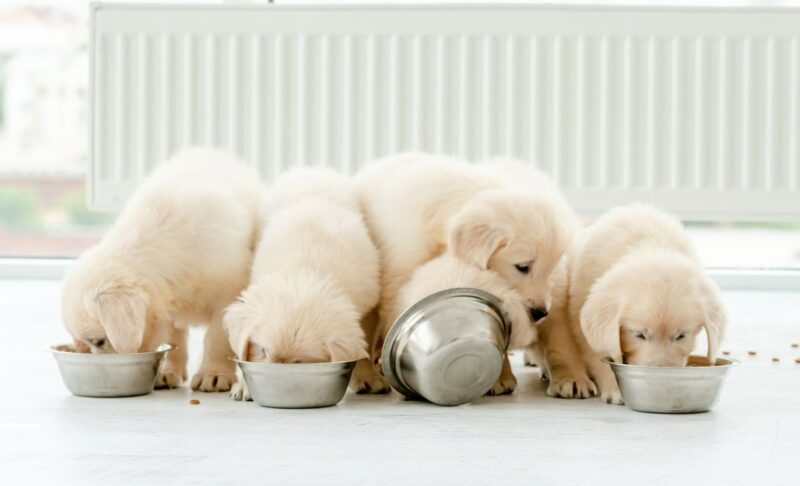
The Association of American Feed Control Officials (AAFCO) recommends two different nutritional profiles for dog foods; one set of recommendations applies to adult dogs (called a “maintenance diet”), while the other applies to growing puppies and reproductively active females (which is called a “growth and reproduction” diet).
Among the differences in essential vitamins and minerals, growing puppies require more protein and amino acids than adults do, as well as more fat, calcium, and phosphorus for healthy growth.
Specifically, at least 22% of a puppy food’s calories should come from protein, while protein only needs to provide about 18% of the calories in an adult dog’s food (though many adult dog foods exceed this level of protein). In practice, many of the best puppy food recipes provide even more protein — 22% protein content represents the minimum daily requirements needed to keep a puppy healthy.
More (within reason) is even better for growing pups! Accordingly, most common puppy foods draw about 30% of their calories from protein.
Additionally, most high-quality, best puppy foods with balanced diets are fortified with additional vitamins and minerals. Some even include immune-system-boosting antioxidants and omega-3 fatty acids to ensure your new puppy’s brain develops properly.
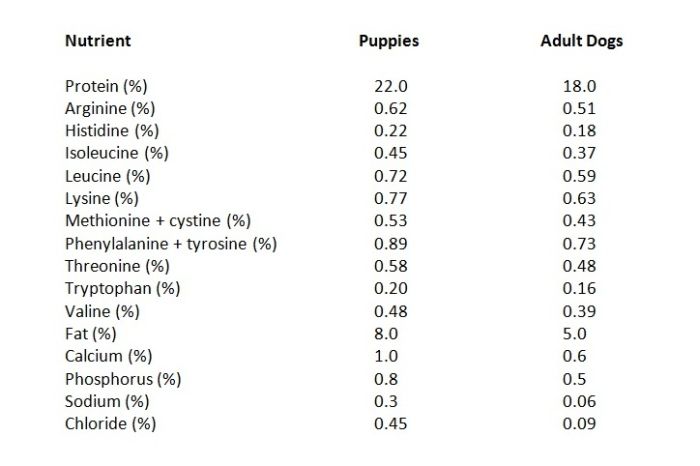
When Are Puppies Ready for Food?
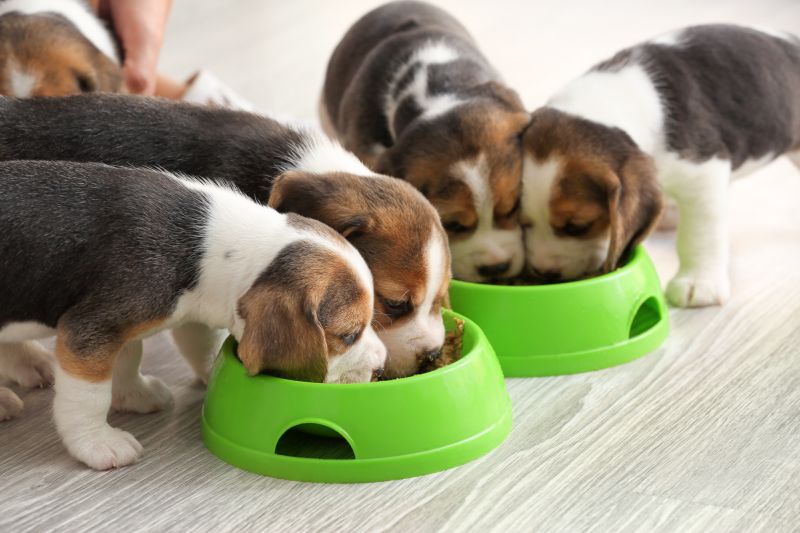
Most breeders and shelters won’t release new puppies until they’re at least 8 weeks of age.
By this time, the puppies should already be fully weaned and ready to eat regular puppy food.
But if you end up caring for puppies that are younger than this, you’ll need to help wean them from milk to puppy food in a gradual manner.
You can usually start the weaning process once your puppy reaches 3.5 to 4.5 weeks of age. But you can’t just plop a bowl of dog food in front of your hungry pup and expect him to start chowing down.
Instead, you’ll need to make a “gruel” comprised of a small amount of wet or dry dog food, which has been mixed with milk replacement formula.
Gently press your puppy’s nose into the bowl, so he’ll start lapping up the milk (as well as the small bits of the food that are mixed in).
Over the next few weeks, you’ll gradually begin using less milk replacement formula in the mixture.
By 6 weeks of age, most puppies should be eating dog food without any milk replacement formula added.
How Much Dog Food Do Growing Puppies Need?
New owners are often unsure how much dog food to give their new puppy at mealtime.
Do you fill up her bowl? Just let her eat as much as she wants?
Some owners even make the mistake of leaving a bowl of dog food available at all times (called ad libitum or on-demand feeding).
In most cases, you should just follow the manufacturer’s instructions on the packaging.
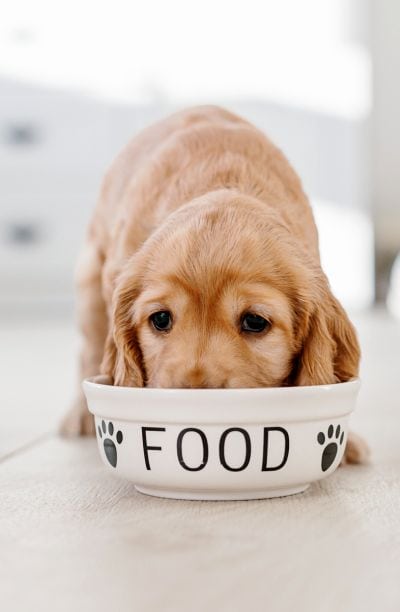
These puppy feeding recommendations usually fall within the veterinary-recommended range, although they are occasionally so broad that they are useless.
For example, a given dog food may advise providing your dog with 2 to 4 ½ cups of food per day. As you can see, the high-end of this range provides more than double the calories of the low-end recommendation, so that’s really not a helpful range.
Discuss your pup’s caloric needs with your veterinarian, but you can figure out a ballpark figure by applying a slightly complex formula, if you like.
It is usually advisable to provide your puppy’s food in three relatively small meals, spread throughout the day.
This will keep your little pup’s tummy full, prevent her from over-indulging at dinner time and also help her avoid intestinal troubles.
Try to feed your puppy’s meals at about the same time each day, and make sure that you discard any uneaten puppy food (particularly wet foods) within 20 to 30 minutes. This will help prevent your pet from eating spoiled food.
Once your dog has reached about 80% to 90% of her adult size, you can cut back to twice-daily feedings (although each meal will consist of relatively more dog food to ensure she still gets the calories she needs).
Additionally, you can transition her to a diet formulated for adults at this time. Just be sure to do so gradually, to avoid stressing her digestive system.
Things to Look For When Selecting a Puppy Food: What Should Puppies Eat?
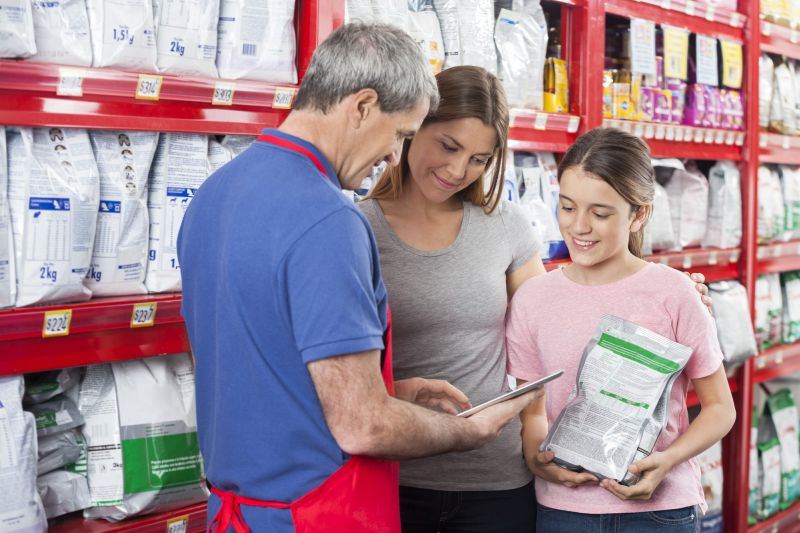
A number of characteristics can help you distinguish the differences between puppy foods of various qualities – no doubt you only want the best for your pup!
- Pick a puppy food that is formulated to meet the AAFCO’s guidelines for “growth and reproduction” or “all life stages”. We mentioned this earlier, but it bears repeating. Puppies have special nutritional requirements, so you’ll need to select a dog food that’s designed to meet these needs.
- Select a puppy food that’s suitable for large-breed puppies if your dog will likely exceed 70 pounds in weight. Large-breed puppies have additional nutritional requirements, so be sure to look for a large-breed puppy food for your new little mastiff, Saint Bernard, or German shepherd.
- Select a dog food that addresses any specific health conditions or concerns your puppy has. For example, if your pooch is allergic to chicken, you’ll obviously want to avoid dog foods that have any chicken-based products. This includes not only deboned chicken, but chicken meal, chicken fat, chicken organ meats, or even — in some cases — eggs. Similarly, if your pooch suffers from something like kidney problems, you’ll want to select a specialized diet with a renal support formula.
- Make sure your vet approves of your choice. This is a critical step in the dog food-selecting process that many owners neglect. But your vet knows your puppy better than anyone but you, and he or she will be able to verify that you’ve picked a chow that will satisfy your dog’s needs and give her the best chance of growing into a healthy adult.
As long as you follow these guidelines, you’ll likely end up with a puppy food that’s perfectly adequate for your little floof. But, there are a few other things you can consider if you would like to end up with the very best dog food possible. This includes things like:
- Select a dog food with high-quality meat proteins at the top of the ingredient list. Generally speaking, you’ll want to see a whole protein listed first, and — in a perfect scenario — you’ll see properly labelled meat meals further down the ingredient list.
- Look for a dog food with whole grains. Contrary to popular thought, most puppies digest cooked grains without issue. So, it’s generally best to look for a grain-inclusive dog food recipe that’s made with whole (unprocessed) healthy grains like wheat, rice, or oatmeal. Doing so may help your dog avoid health problems in the future (more on this below).
- Pay attention to the where dog foods are manufactured. Select products that are manufactured in a country with high pet-food quality standards. Although it is difficult to make broad generalizations, dog foods made in Australia, New Zealand, Western Europe, Canada or the United States generally fit the bill, while most Asian-made products should be avoided.
- In addition to being made in western countries, look for dog food that only includes ingredients sourced from western countries too. This is admittedly harder to find, as many supplements are difficult to source from the US or other western countries. But the brands that do source ingredients from western countries tend to be those making the best puppy food. Several fresh foods do fit this bill (with Nom Nom being a great example), but there are also a small number of traditional foods that use only US-sourced products too.
- Look for dog foods with nutritional “extras.” The best puppy food formulas typically contain supplements that help improve the value of the recipe. Some of the most important supplements to look for include chondroitin, glucosamine, omega-3-rich ingredients, omega-6 fatty acids, and probiotics. Chondroitin and glucosamine help to support joint health, omega-3 fatty acids help prevent inflammation, and probiotics help promote proper digestion.
- When possible, select a puppy food made by a brand that employs a full-time, credentialed nutritionist. This will help ensure that someone educated in the ins and outs of proper pooch nutrition is involved in the recipe-crafting process.
Dog Food Brands to Avoid: Steering Clear of the Worst Puppy Foods

Understanding the things you want to look for when picking the best puppy food for your little one is important, but it is also important that you understand which dog food brands to avoid. We’ll try to help you do so below, as we explain some of the red flags you’ll want to watch out for.
- Steer clear of mystery meats. You’ll want to steer clear of any dog foods with unidentified animal meals or fats derived from unidentified meats. For safety’s sake, it is best to avoid puppy foods that don’t indicate the sources for their additives. Meat meals and rendered fats are not inherently problematic, but you need to know from which animal these by-products originated.
- Avoid puppy foods with artificial flavors or colors. Many of the worst puppy foods contain a variety of unnecessary additives in preservatives, so you’ll want to avoid these foods whenever possible. In most cases, the fewer ingredients listed on the bag of dog food, the better.
- Try to avoid puppy foods with processed or enriched grains. Grains are usually perfectly acceptable carbohydrates for puppies, but there are some grains that are better for dogs than others. Whole grains are much better for your pooch than refined or processed grains are. Refined grains typically lack the fiber content of unrefined grains, and they won’t keep your pet full for very long, either.
Do Puppies Need a Grain-Free Puppy Food?
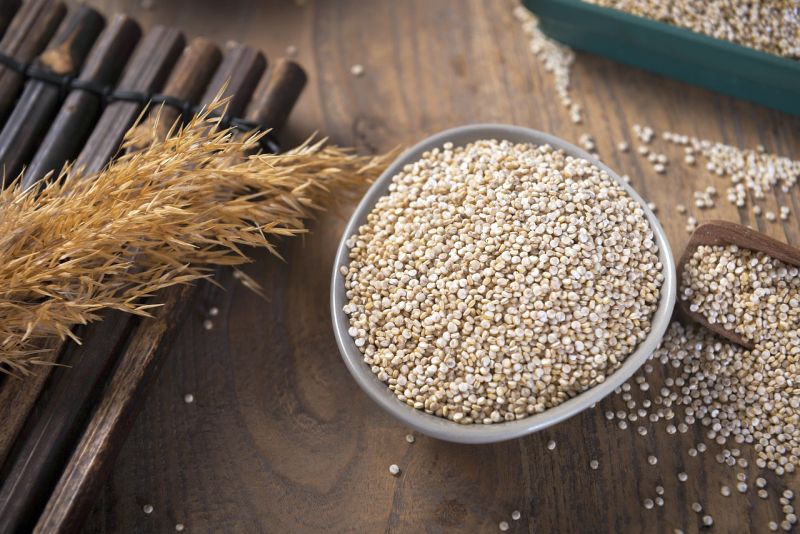
There’s a lot of talk about grain-free dog foods, which causes many new owners to begin looking for the best grain-free puppy food.
But this begs the question: Do puppies need a grain-free puppy food?
Generally speaking, no — while grain-free dog food diets are preferable in some specific circumstances (such as dogs who are allergic to a specific type of grain), they aren’t usually necessary.
In fact, the FDA has released some information that indicates a correlation between grain-free dog food and dilated cardiomyopathy (DCM).
For this reason, it’s not recommended to feed your dog a grain-free diet unless other factors are at play, such as allergies.
Some grains are certainly better for your pet than others (for example, whole grains are much healthier than enriched or processed grains), but there’s no reason to deliberately seek out a grain-free recipe for a typical, healthy puppy.
What About Dog Food Marketed for “All Life Stages?”

Some dog food manufacturers try to fish with a big net and market foods designed to be suitable for puppies and adults.
To do so in accordance with the AAFCO’s labeling requirements, such foods need only demonstrate that they meet the nutritional requirements for puppies and adults.
But because the nutritional requirements of foods designed for growing dogs exceed those required for adults, these foods are essentially puppy food.
It is therefore perfectly acceptable to offer “all life stages” foods to young puppies.
However, problems with such foods may manifest in adult dogs, who may not need the higher protein and fat content that characterizes puppy foods.
Some adult dogs – particularly those with high caloric needs – may be able to tolerate such rich food on a daily basis, but others will become overweight and subject to joint problems and other ailments.
Consider Your Canine’s Size: The Best Puppy Food for Large Breeds
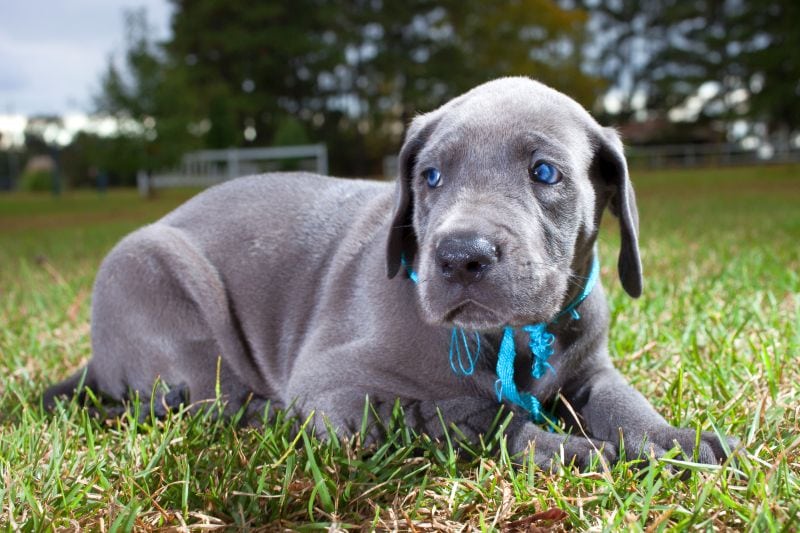
It’s important to note that large-breed puppies have slightly different nutritional needs than small- to medium-sized breeds do.
This means that the best puppy food for large breed dogs is one that is specifically formulated to meet the needs of soon-to-be-big dogs.
Fortunately, there are a number of dog foods on the market that are perfect for soon-to-be big pups.
Generally speaking, the best puppy food designed for large-breed puppies differ in the following ways:
- They contain less calcium
- They contain less phosphorus
- They are leaner and have less fat
- They often have fewer calories per cup
Additionally, many dog foods specifically designed for large-breed puppies also contain joint-supporting supplements, such as chondroitin and glucosamine.
The 50-pound mark is often recognized as the line that distinguishes large breeds from small- and medium-sized breeds, but this isn’t set in stone.
Just be sure to speak with your vet if you’re not sure whether a large-breed dog food is right for your dog.
Wet, Semi-Moist or Dry? Which Dog Food Is Best for Your Pup?
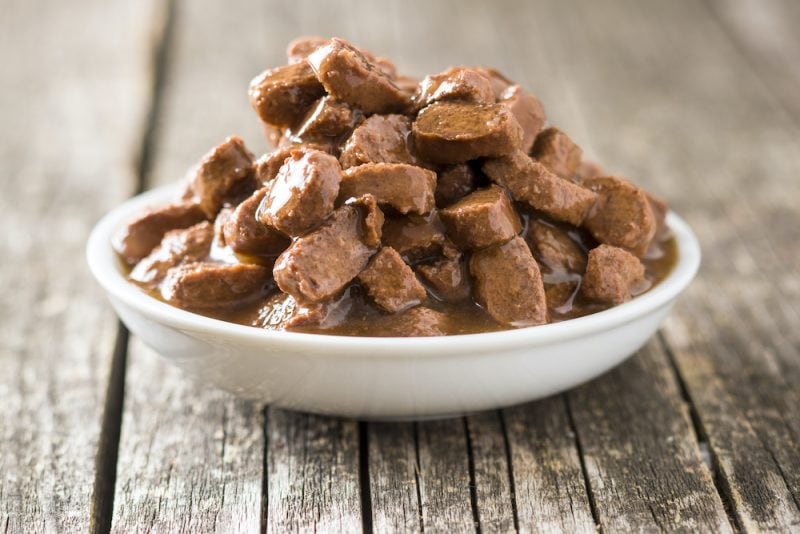
Dog foods are available in three different preparations.
Wet food is typically (but not always) packaged in a can, semi-moist food is packaged in sealed plastic bags, and dry foods usually come in a wax-coated paper bag. When it comes to wet vs dry dog food, each type of food has its own pros and cons.
- Dry Dog Food. Dry dog food is the preferred choice for most dogs, as it typically has the highest protein content and is the easiest to store. Dry dog food is usually the most economical option of the three styles, and the hard kibble bits tend to scrape food and plaque from your dog’s teeth, which provides dental benefits for your growing pup.
- Wet Dog Food. As the name suggests, wet dog food is full of water, which means that less of your money is going to protein and more of it is going to paying for something that comes out of your tap for free. Wet dog foods do not provide any dental benefits for dogs, which is unfortunate, as most dogs love the taste of canned foods.
- Semi-Moist Dog Food. Semi-moist dog foods have largely been replaced by wet foods in the marketplace, so you won’t see tons of semi-moist options at your local pet store. You aren’t missing out – only a few of these are designed for young dogs, so semi-moist foods aren’t usually a good choice for puppy owners.
You may want to mix some wet puppy food in with your dog’s normal kibble for a tasty combo. This gives you a chance to spoil your dog with the flavor of wet food, while capitalizing on the affordability of kibble.
Can You Use a Homemade Puppy Food for Your New Pet?
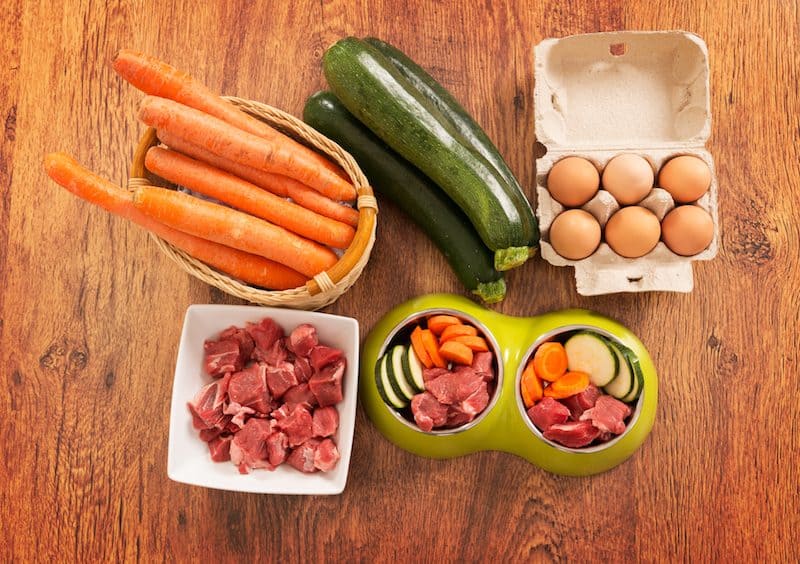
A lot of owners consider making a homemade puppy food for their new pet. It’s certainly possible to do so, but it’s generally not a good idea.
Creating a homemade food for adult dogs is tricky at best, and it requires a lot more research and expertise than the average owner is willing or able to invest.
And because a puppy’s nutritional needs are even more challenging to satisfy than those of adults, it’s wiser to simply rely on a commercially prepared diet that is specifically designed to meet the needs of growing puppies.
If you have your heart set on feeding your pet a homemade food, just wait until your little floof has reached adulthood (and then be sure that you work closely with your vet while designing the recipe).
Transition Dog Foods Slowly to Avoid Digestive Difficulties

It is always a good idea to make any changes to your dog’s diet slowly, over the course of about five to seven days.
This will give your pup’s body a little more time to adjust to his new food, which will usually help eliminate or minimize any intestinal disturbances.
A typical transition should unfold as follows:
- Day One – Fill your pup’s bowl 90% of the way with the old food and mix in 10% of his new food
- Day Two – Fill your pup’s bowl 75% of the way with old food and mix in 25% of his new food
- Day Three – Fill your pup’s bowl 50% of the way with old food and mix in 50% of his new food
- Day Four – Fill your pup’s bowl 25% of the way with old food and mix in 75% of his new food
- Day Five – Fill your pup’s bowl 10% of the way with old food and mix in 90% of his new food
- Day Six – Discontinue feeding the old food entirely and fill your pup’s bowl with his new food only
This schedule isn’t written in stone, and you should feel free to tweak it slightly. Just be sure that you are giving your puppy’s body enough time to make the transition and you should be able to avoid most types of stomach upset.
Puppy-Feeding FAQs: Your Puppy Food Questions Answered!
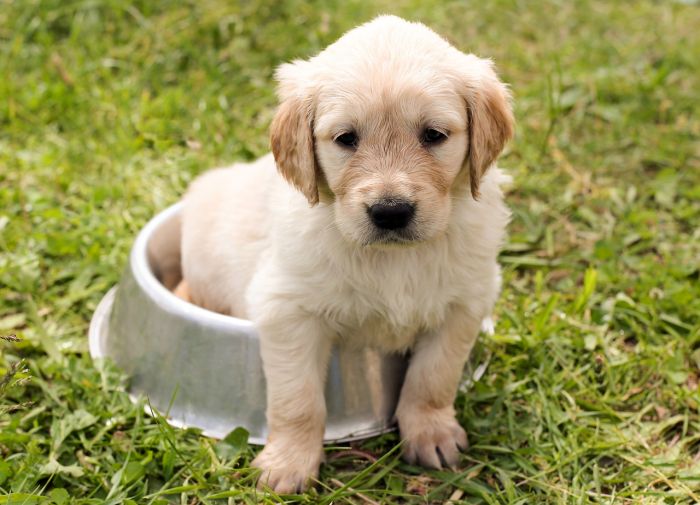
Still have questions about feeding your new puppy? It’s understandable! After all, there’s a lot to learn about feeding your new four-footer, so don’t feel bad.
We’ll try to help you further by answering some of the most common puppy-feeding questions new owners have below!
When and how often should I feed my puppy?
It’s recommended that you feed your puppy three relatively small meals spread throughout the day.
Morning, noon, and evening are common feeding times. This will keep your pup’s stomach satisfied while avoiding any intestinal troubles.
How much food should I feed my puppy?
Follow the puppy food manufacturer’s guidelines on how much to feed your puppy. Generally, this can be anywhere from 2-5 cups or more, depending on your puppy’s current size and estimated adult size.
When should I switch my puppy to adult food?
You can switch your puppy to adult dog food once she has reached 80% – 90% of her adult size. Usually, this happens around 9-12 months for small breeds and 12-24 months for larger breeds.
What breeds are at greatest risk for hip dysplasia?
Hip dysplasia is more likely to affect larger breed dogs. For this reason, it’s important to feed these pups specialized large-breed puppy food, which is formulated to lower the risk of hip dysplasia.
How do I know if my puppy is a large breed?
Puppy paws can sometimes be used as an indicator of full adult size. If your unknown origin puppy has unusually large paws, chances are he may be a large breed pup. However, dog DNA tests are the only surefire way to know your puppy’s breed.
Any of these listed foods should help your tiny little puppy grow into a healthy adult. Just be sure to select a dog food well suited for your puppy’s specific needs. Look over the ingredients and find the one that works best for you.
Want the best for your pup? Consider reading our guides on:
- The best dog beds for puppies
- The best chew toys for pups for teething pups
- How to house train a puppy
We’d love to hear your experiences with these puppy foods. Let us know how they’ve worked out for you in the comments below.

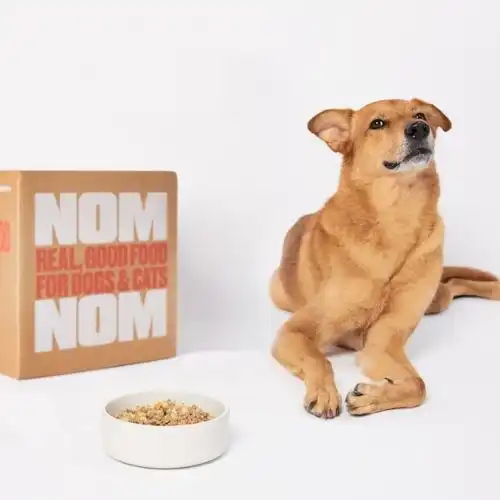
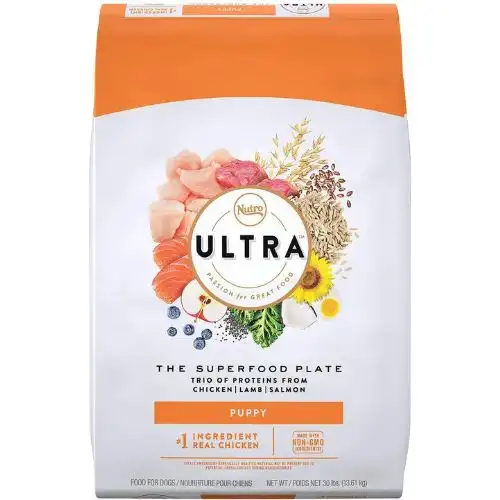
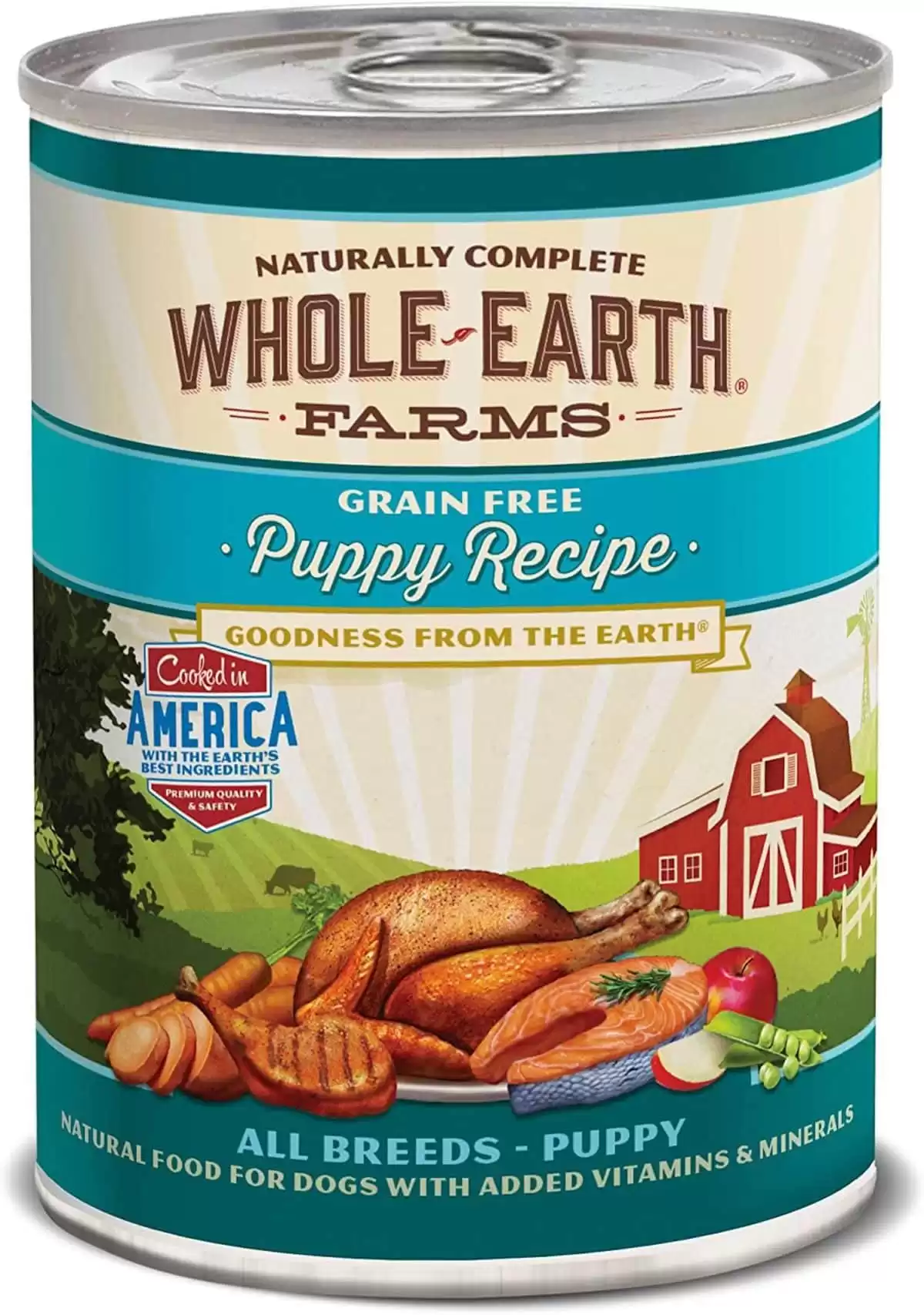
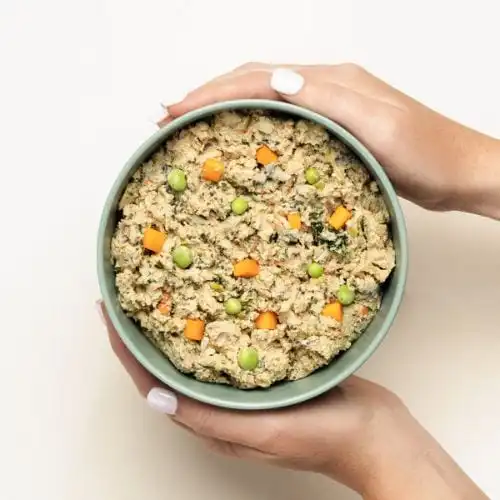
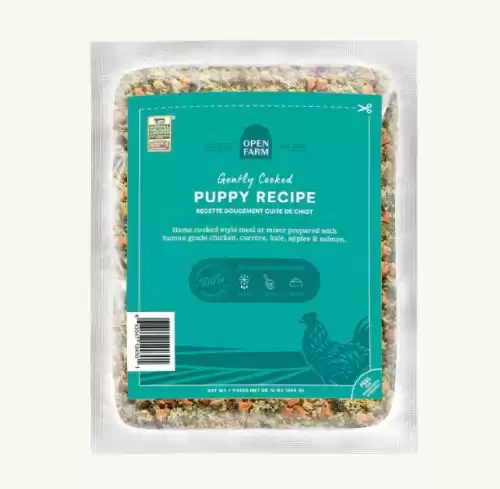
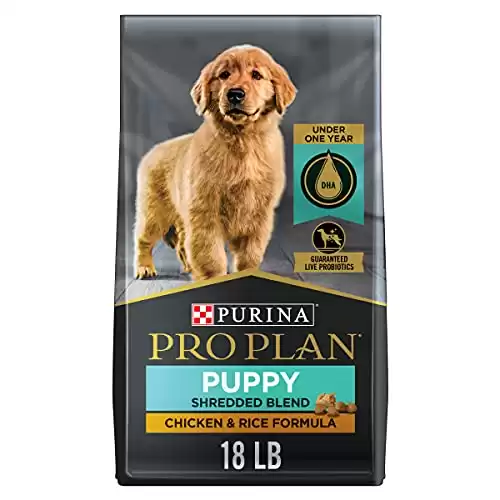
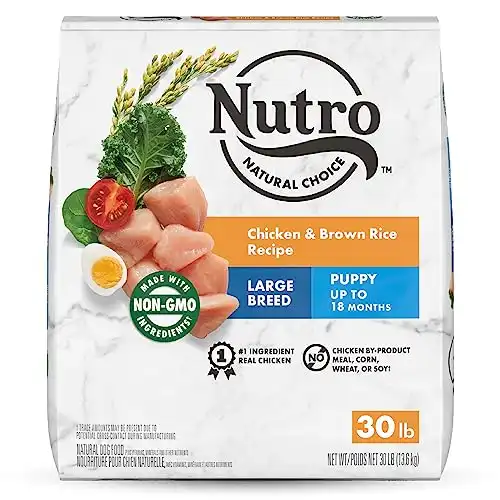
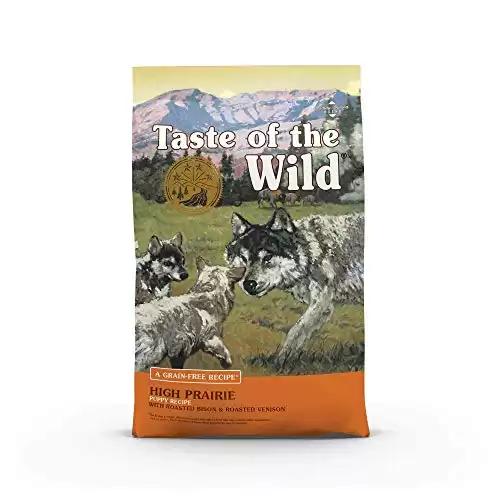
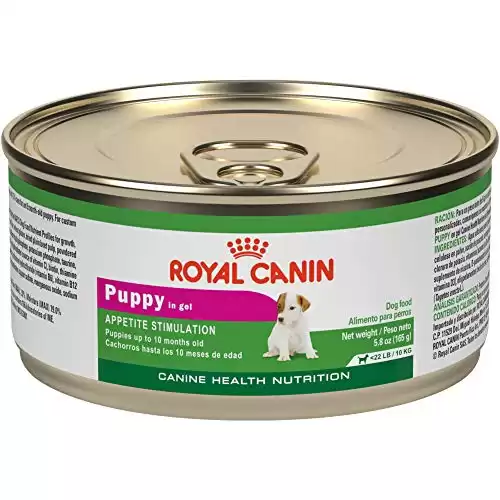
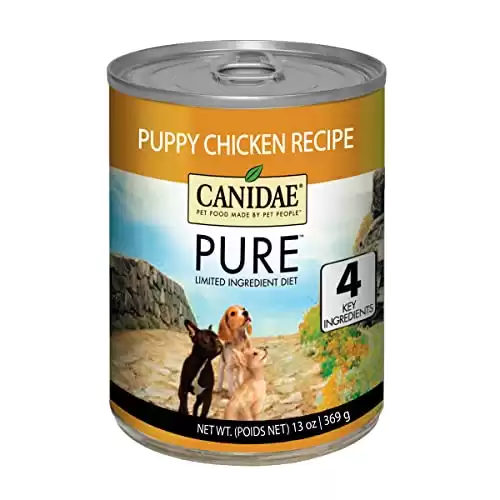
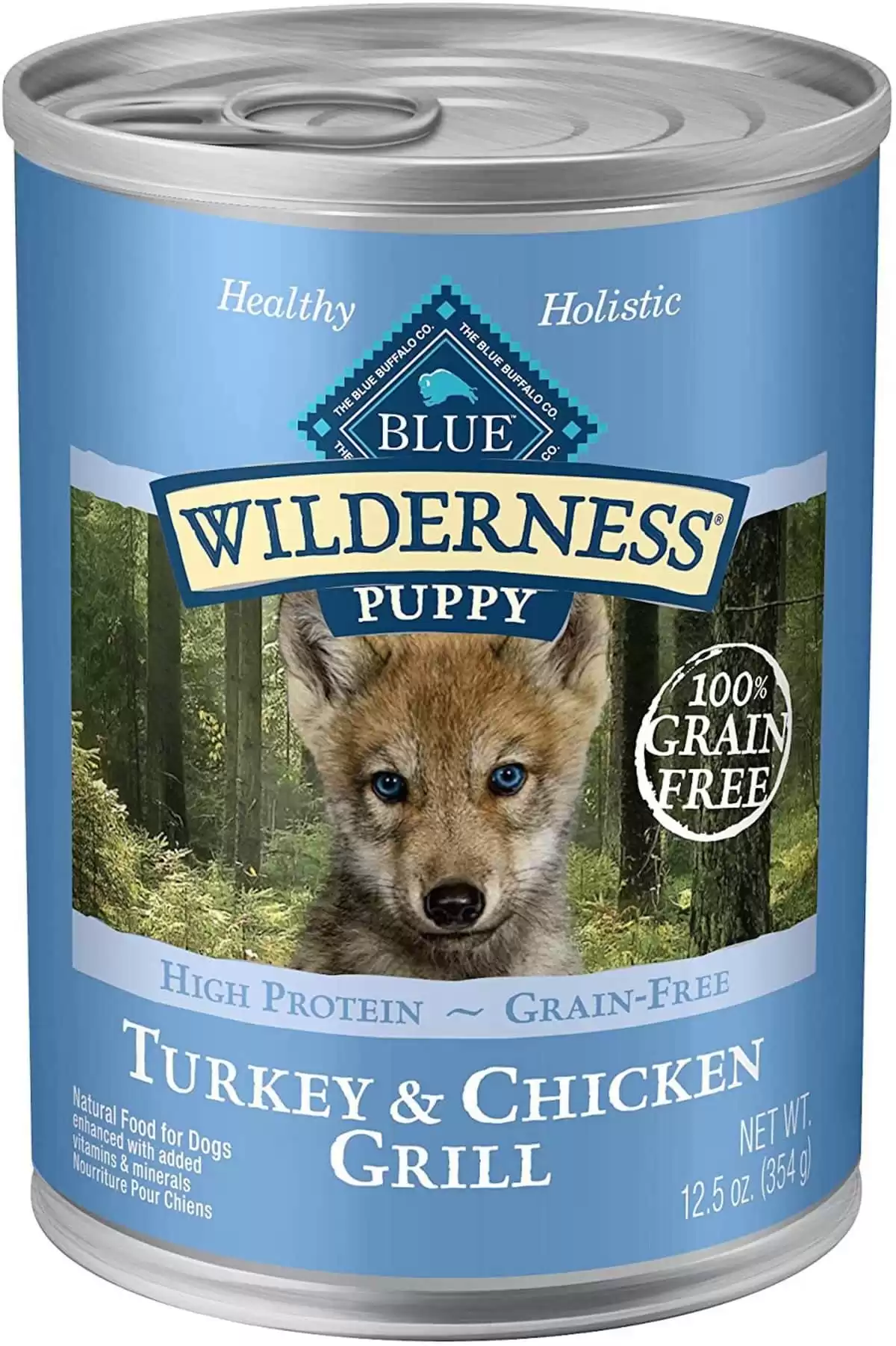

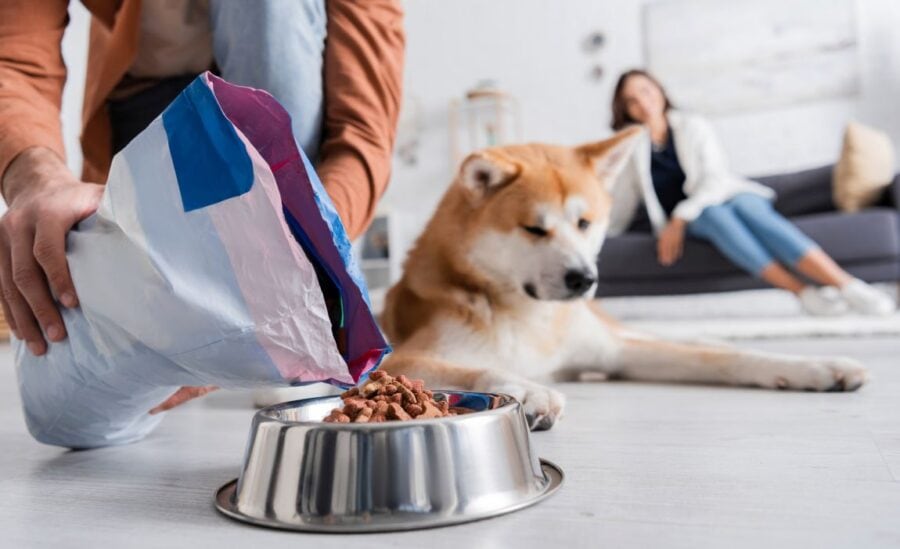


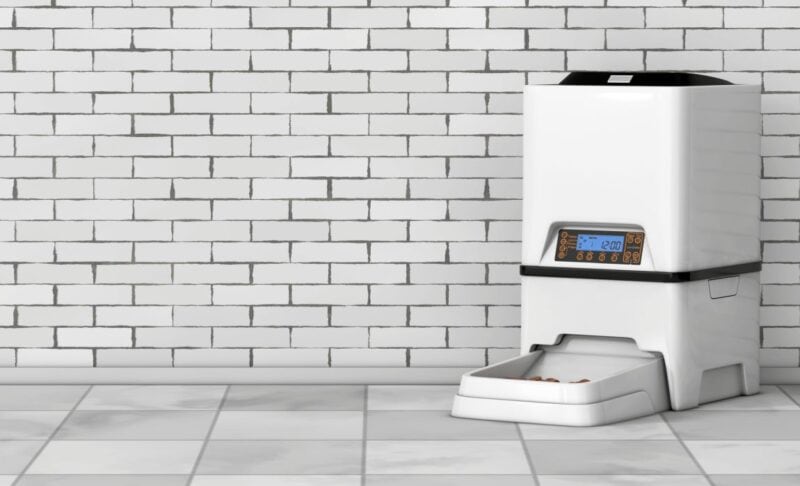
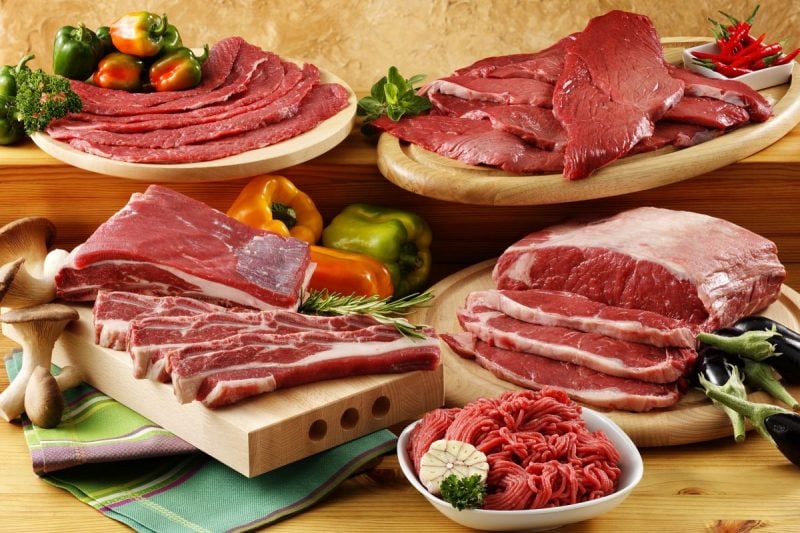

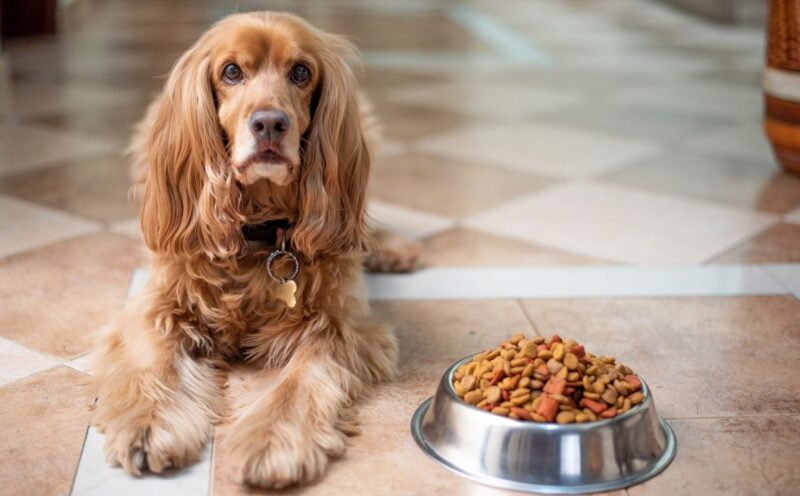

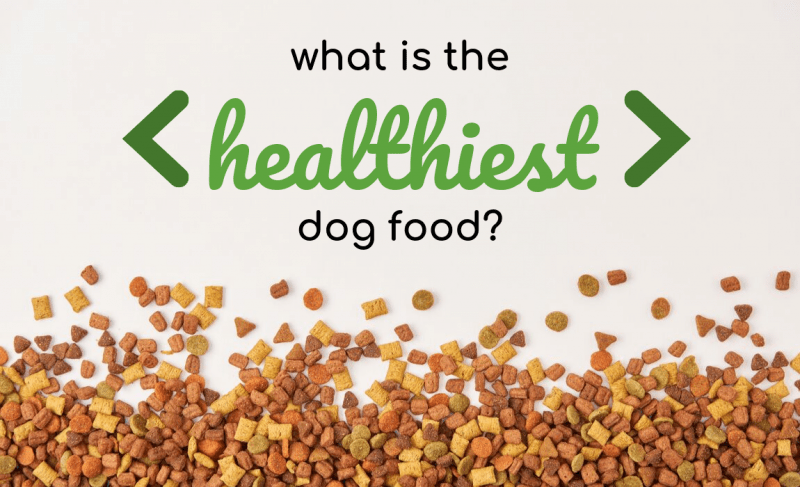
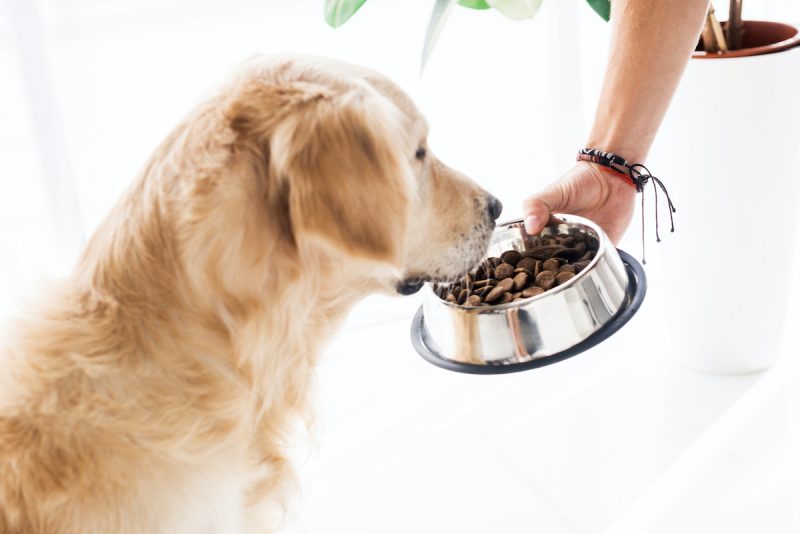

Leave a Comment